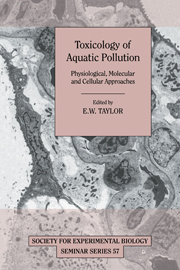Book contents
- Frontmatter
- Contents
- List of contributors
- Preface
- Water chemistry at the gill surfaces of fish and the uptake of xenobiotics
- Bioaccumulation of waterborne 1,2,4,5-tetrachlorobenzene in tissues of rainbow trout
- Dietary exposure to toxic metals in fish
- The physiology and toxicology of zinc in fish
- Lethal and sub-lethal effects of copper upon fish: a role for ammonia toxicity?
- The physiological status of brown trout exposed to aluminium in acidic soft waters
- Physiological and metabolic costs of acclimation to chronic sub-lethal acid and aluminium exposure in rainbow trout
- Physiological effects of nitrite in teleosts and crustaceans
- Metallothioneins in fish: induction and use in environmental monitoring
- Oestrogenic substances in the aquatic environment and their potential impact on animals, particularly fish
- Effect of genetic toxicants in aquatic organisms
- In vitro toxicology of aquatic pollutants: use of cultured fish cells
- Principles governing the use of cytochrome P4501A1 measurement as a pollution monitoring tool in the aquatic environment
- Index
Metallothioneins in fish: induction and use in environmental monitoring
Published online by Cambridge University Press: 20 May 2010
- Frontmatter
- Contents
- List of contributors
- Preface
- Water chemistry at the gill surfaces of fish and the uptake of xenobiotics
- Bioaccumulation of waterborne 1,2,4,5-tetrachlorobenzene in tissues of rainbow trout
- Dietary exposure to toxic metals in fish
- The physiology and toxicology of zinc in fish
- Lethal and sub-lethal effects of copper upon fish: a role for ammonia toxicity?
- The physiological status of brown trout exposed to aluminium in acidic soft waters
- Physiological and metabolic costs of acclimation to chronic sub-lethal acid and aluminium exposure in rainbow trout
- Physiological effects of nitrite in teleosts and crustaceans
- Metallothioneins in fish: induction and use in environmental monitoring
- Oestrogenic substances in the aquatic environment and their potential impact on animals, particularly fish
- Effect of genetic toxicants in aquatic organisms
- In vitro toxicology of aquatic pollutants: use of cultured fish cells
- Principles governing the use of cytochrome P4501A1 measurement as a pollution monitoring tool in the aquatic environment
- Index
Summary
General background
Heavy metals cause an abundance of effects on all living animals. In fish there is a multitude of information on different alterations that are caused by cadmium, copper, zinc and mercury (Sorensen, 1991). Heavy metals affect every level of organization from the society (behaviour) to the organism (reproductive) and sub-cellular level (enzymatic and composition changes). The effects can be general to all of the metals or highly metal specific. Since the organism can not destroy the metals by metabolic degradation, the only way in which an organism can protect itself from heavy metal poisoning is by decreasing the rate of uptake, by binding the metals to a ligand that will hinder the metal from disrupting normal physiological processes or increase the rate of excretion.
Metallothionein with its exceptionally high content of thiol groups is extremely effective in binding heavy metal ions. Metallothioneins are widely distributed in nature and are generally considered to be involved in zinc and copper homeostasis, heavy metal detoxification and possibly as a free radical scavenger (Hamer, 1986). As well as being able to bind group IB and IIB heavy metals, metallothionein is also induced by addition of these metals (Zafarullah, Olsson & Gedamu, 19896). Studies on fish and fish cell lines have further shown that the hepatic metallothionein levels are elevated by glucocorticoids, noradrenalin and progesterone (Hyllner et ai, 1989; Olsson et al, 199(k, George et al, 1992). Metallothionein has further been shown to be endogenously regulated during different developmental life stages (Olsson et al, 1990b). An understanding of the complex and highly controlled regulation of metallothionein in fish is necessary if the system is to be used in environmental monitoring.
- Type
- Chapter
- Information
- Toxicology of Aquatic PollutionPhysiological, Molecular and Cellular Approaches, pp. 187 - 204Publisher: Cambridge University PressPrint publication year: 1996
- 14
- Cited by



